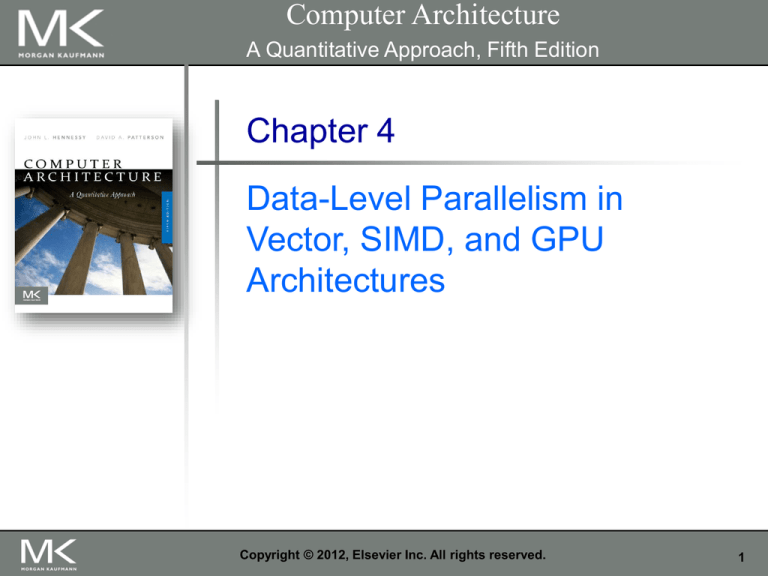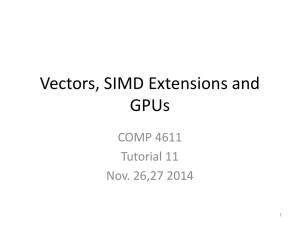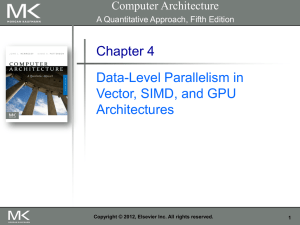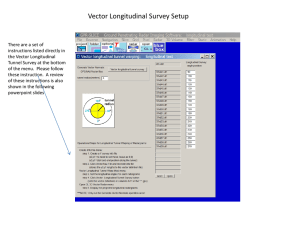
Computer Architecture
A Quantitative Approach, Fifth Edition
Chapter 4
Data-Level Parallelism in
Vector, SIMD, and GPU
Architectures
Copyright © 2012, Elsevier Inc. All rights reserved.
1
SIMD architectures can exploit significant datalevel parallelism for:
matrix-oriented scientific computing
media-oriented image and sound processors
SIMD is more energy efficient than MIMD
Introduction
Introduction
Only needs to fetch one instruction per data operation
Makes SIMD attractive for personal mobile devices
SIMD allows programmer to continue to think
sequentially
Copyright © 2012, Elsevier Inc. All rights reserved.
2
Vector architectures
SIMD extensions
Graphics Processor Units (GPUs)
For x86 processors:
Introduction
SIMD Parallelism
Expect two additional cores per chip per year
SIMD width to double every four years
Potential speedup from SIMD to be twice that from
MIMD!
Copyright © 2012, Elsevier Inc. All rights reserved.
3
Basic idea:
Read sets of data elements into “vector registers”
Operate on those registers
Disperse the results back into memory
Vector Architectures
Vector Architectures
Registers are controlled by compiler
Used to hide memory latency
Leverage memory bandwidth
Copyright © 2012, Elsevier Inc. All rights reserved.
4
Example architecture: VMIPS
Loosely based on Cray-1
Vector registers
Fully pipelined
Data and control hazards are detected
Vector load-store unit
Each register holds a 64-element, 64 bits/element vector
Register file has 16 read ports and 8 write ports
Vector functional units
Vector Architectures
VMIPS
Fully pipelined
One word per clock cycle after initial latency
Scalar registers
32 general-purpose registers
32 floating-point registers
Copyright © 2012, Elsevier Inc. All rights reserved.
5
VMIPS
basic vector
architecture
Copyright © 2012, Elsevier Inc. All rights reserved.
6
ADDVV.D: add two vectors
ADDVS.D: add vector to a scalar
LV/SV: vector load and vector store from address
Vector Architectures
VMIPS Instructions
Example: DAXPY (Y=a*X + Y)
L.D
F0,a
; load scalar a
LV
V1,Rx
; load vector X
MULVS.D
V2,V1,F0
; vector-scalar multiply
LV
V3,Ry
; load vector Y
ADDVV
V4,V2,V3
; add
SV
Ry,V4
; store the result
Requires 6 instructions vs. almost 600 for MIPS
Copyright © 2012, Elsevier Inc. All rights reserved.
7
Execution time depends on three factors:
VMIPS functional units consume one element
per clock cycle
Length of operand vectors
Structural hazards
Data dependencies
Vector Architectures
Vector Execution Time
Execution time is approximately the vector length
Convey
Set of vector instructions that could potentially
execute together
Copyright © 2012, Elsevier Inc. All rights reserved.
8
Sequences with read-after-write dependency
hazards can be in the same convey via chaining
Chaining
Vector Architectures
Chimes
Allows a vector operation to start as soon as the
individual elements of its vector source operand
become available
Chime
Unit of time to execute one convey
m conveys executes in m chimes
For vector length of n, requires m x n clock cycles
Copyright © 2012, Elsevier Inc. All rights reserved.
9
LV
MULVS.D
LV
ADDVV.D
SV
Convoys:
1
LV
2
LV
3
SV
V1,Rx
V2,V1,F0
V3,Ry
V4,V2,V3
Ry,V4
;load vector X
;vector-scalar multiply
;load vector Y
;add two vectors
;store the sum
Vector Architectures
Example
MULVS.D
ADDVV.D
3 chimes, 2 FP ops per result, cycles per FLOP = 1.5
For 64 element vectors, requires 64 x 3 = 192 clock cycles
Copyright © 2012, Elsevier Inc. All rights reserved.
10
Start up time
Latency of vector functional units
Assume the same as Cray-1:
Vector Architectures
Challenges
Floating-point add => 6 clock cycles
Floating-point multiply => 7 clock cycles
Floating-point divide => 20 clock cycles
Vector load => 12 clock cycles
Improvements:
> 1 element per clock cycle
Non-64 wide vectors
IF statements in vector code
Memory system optimizations to support vector processors
Multiple dimensional matrices
Sparse matrices
Programming a vector computer
Copyright © 2012, Elsevier Inc. All rights reserved.
11
Element n of vector register A is “hardwired” to element
n of vector register B
Allows for multiple hardware lanes
Copyright © 2012, Elsevier Inc. All rights reserved.
Vector Architectures
Multiple Lanes
12
Vector length not known at compile time?
Use Vector Length Register (VLR)
Use strip mining for vectors over the maximum length:
Vector Architectures
Vector Length Register
low = 0;
VL = (n % MVL); /*find odd-size piece using modulo op ; MVL=Max Vector Length% */
for (j = 0; j <= (n/MVL); j=j+1) { /*outer loop*/
for (i = low; i < (low+VL); i=i+1) /*runs for length VL*/
Y[i] = a * X[i] + Y[i] ; /*main operation*/
low = low + VL; /*start of next vector*/
VL = MVL; /*reset the length to maximum vector length*/
}
Copyright © 2012, Elsevier Inc. All rights reserved.
13
Consider:
for (i = 0; i < 64; i=i+1)
if (X[i] != 0)
X[i] = X[i] – Y[i];
Use vector mask register to “disable” elements:
LV
LV
L.D
SNEVS.D
SUBVV.D
SV
V1,Rx
V2,Ry
F0,#0
V1,F0
V1,V1,V2
Rx,V1
Vector Architectures
Vector Mask Registers
;load vector X into V1
;load vector Y
;load FP zero into F0
;sets VM(i) to 1 if V1(i)!=F0
;subtract under vector mask
;store the result in X
GFLOPS rate decreases!
Copyright © 2012, Elsevier Inc. All rights reserved.
14
Memory system must be designed to support high
bandwidth for vector loads and stores
Spread accesses across multiple banks
Vector Architectures
Memory Banks
Control bank addresses independently
Load or store non sequential words
Support multiple vector processors sharing the same memory
Example:
32 processors, each generating 4 loads and 2 stores/cycle
Processor cycle time is 2.167 ns, SRAM cycle time is 15 ns
How many memory banks needed?
Copyright © 2012, Elsevier Inc. All rights reserved.
15
Consider:
for (i = 0; i < 100; i=i+1)
for (j = 0; j < 100; j=j+1) {
A[i][j] = 0.0;
for (k = 0; k < 100; k=k+1)
A[i][j] = A[i][j] + B[i][k] * D[k][j];
}
Must vectorize multiplication of rows of B with columns of D
Use non-unit stride
Bank conflict (stall) occurs when the same bank is hit faster than
bank busy time:
Vector Architectures
Stride
#banks / LCM(stride,#banks) < bank busy time
See example pg 279
Copyright © 2012, Elsevier Inc. All rights reserved.
16
Vector Architectures
Scatter-Gather
Consider:
for (i = 0; i < n; i=i+1)
A[K[i]] = A[K[i]] + C[M[i]];
Use index vector:
LV
Vk, Rk
LVI
Va, (Ra+Vk)
LV
Vm, Rm
LVI
Vc, (Rc+Vm)
ADDVV.D Va, Va, Vc
SVI
(Ra+Vk), Va
;load K
;load A[K[]]
;load M
;load C[M[]]
;add them
;store A[K[]]
Copyright © 2012, Elsevier Inc. All rights reserved.
17
Compilers can provide feedback to programmers
Programmers can provide hints to compiler
Copyright © 2012, Elsevier Inc. All rights reserved.
Vector Architectures
Programming Vec. Architectures
18
Media applications operate on data types narrower than
the native word size
Example: disconnect carry chains to “partition” adder
Limitations, compared to vector instructions:
Number of data operands encoded into opcode (i.s.o.
using VL register)
No sophisticated addressing modes (like strided,
scatter-gather)
No mask registers
Copyright © 2012, Elsevier Inc. All rights reserved.
SIMD Instruction Set Extensions for Multimedia
SIMD Extensions
19
Implementations:
Intel MMX (1996)
Streaming SIMD Extensions (SSE) (1999)
Eight 16-bit integer ops
Four 32-bit integer/fp ops or two 64-bit integer/fp ops
Advanced Vector Extensions (AVX 2010)
Eight 8-bit integer ops or four 16-bit integer ops
Four 64-bit integer/fp ops
256 bit vectors -> 512 -> 1024
SIMD Instruction Set Extensions for Multimedia
SIMD Implementations
Operands must be consecutive and aligned memory
locations
Copyright © 2012, Elsevier Inc. All rights reserved.
20
Example DXPY (Y=a*X + Y):
L.D
MOV
MOV
MOV
DADDIU
Loop:
MUL.4D
L.4D
ADD.4D
S.4D
DADDIU
DADDIU
DSUBU
BNEZ
F0,a
F1, F0
F2, F0
F3, F0
R4,Rx,#512
L.4D F4,0[Rx]
F4,F4,F0
F8,0[Ry]
F8,F8,F4
0[Ry],F8
Rx,Rx,#32
Ry,Ry,#32
R20,R4,Rx
R20,Loop
;load scalar a
;copy a into F1 for SIMD MUL
;copy a into F2 for SIMD MUL
;copy a into F3 for SIMD MUL
;last address to load
;load X[i], X[i+1], X[i+2], X[i+3]
;a×X[i],a×X[i+1],a×X[i+2],a×X[i+3]
;load Y[i], Y[i+1], Y[i+2], Y[i+3]
;a×X[i]+Y[i], ..., a×X[i+3]+Y[i+3]
;store into Y[i], Y[i+1], Y[i+2], Y[i+3]
;increment index to X
;increment index to Y
;compute bound
;check if done
Copyright © 2012, Elsevier Inc. All rights reserved.
SIMD Instruction Set Extensions for Multimedia
Example SIMD Code
21
Basic idea:
Plot peak floating-point throughput as a function of
arithmetic intensity
Ties together floating-point performance and memory
performance for a target machine
Arithmetic intensity
Floating-point operations per byte read
Copyright © 2012, Elsevier Inc. All rights reserved.
SIMD Instruction Set Extensions for Multimedia
Roofline Performance Model
22
Attainable GFLOPs/sec Min = (Peak Memory BW ×
Arithmetic Intensity, Peak Floating Point Perf.)
Copyright © 2012, Elsevier Inc. All rights reserved.
SIMD Instruction Set Extensions for Multimedia
Examples
23
Given the hardware invested to do graphics
well, how can be supplement it to improve
performance of a wider range of applications?
Basic idea:
Heterogeneous execution model
Graphical Processing Units
Graphical Processing Units
CPU is the host, GPU is the device
Develop a C-like programming language for GPU
NVIDIA: CUDA
AMD/ATI: Brook+
OpenCL
24
Different design philosophies
CPU
A few out-of-order cores
Sequential computation
GPU
Many in-order cores
Massively parallel computation
Graphical Processing Units
CPU vs. GPU
25
Threads execute kernels
Arranged into blocks (analogous to strip-mined vector loop)
Single-instruction multiple-thread (SIMT) fashion
Threads may diverge: programming flexibility at the expense of
performance reduction
Graphical Processing Units
CUDA programming model
26
DAXPY: vectors of length 8192
Independent loop iterations
Threads in thread blocks
// DAXPY in C
for (int i = 0; i < 8192; ++i)
y[i] = a * x[i] + y[i];
Graphical Processing Units
Example
// DAXPY in CUDA – GPU code
{
int i = blockIdx.x * blockDim.x +
threadIdx.x;
if(i < n) y[i] = a * x[i] + y[i];
}
...
// Kernel invocation – CPU
daxpy<<16, 512>>(n, a, x, y);
27
Graphical Processing Units
Transparent Scalability
Thread block scheduler assigns blocks to any
multithreaded SIMD processor at any time
A kernel scales across any number of SIMD processors
Kernel grid
Block 0 Block 1
Block 2 Block 3
Device
Device
Block 4 Block 5
Block 6 Block 7
Block 0
Block 2
Block 1
Block 3
Block 4
Block 5
Block 6
Block 7
Block 0
Block 1
Block 2
Block 3
Block 4
Block 5
Block 6
Block 7
time
Each block can execute in any order relative
to other blocks
28
Blocks within each SIMD processor:
SIMD lanes: 32 in NVIDIA devices
Wide and shallow compared to vector processors
Graphical Processing Units
GPU computational structures
Threads of SIMD instructions: Warps
Each has its own PC
SIMD thread scheduler uses scoreboard to dispatch
No data dependencies between threads!
Keeps track of up to 48 warps (Fermi)
Latency hiding
29
SIMD processor (Streaming multiprocessor, SM)
16 SIMD lanes (NVIDIA Fermi)
Graphical Processing Units
GPU computational structures
30
SM hardware implements
zero-overhead warp
scheduling
SIMD thread scheduler
time
Operands ready?
Eligible for execution
Graphical Processing Units
Scheduling of SIMD threads
warp 8 instruction 11
warp 1 instruction 42
warp 3 instruction 95
..
.
warp 8 instruction 12
warp 3 instruction 96
3131
Multithreading
Latency hiding
Registers
Long latency operations (memory accesses, special function units)
4 active warps (or SIMD threads)
2 active warps
Graphical Processing Units
Multithreaded architecture
32
Graphical Processing Units
NVIDIA Instruction Set Arch.
ISA is an abstraction of the hardware instruction set
“Parallel Thread Execution (PTX)”
Uses virtual registers
Translation to machine code is performed in software
Example:
shl.s32 R8, blockIdx, 9
; Thread Block ID * Block size (512 or 29)
add.s32 R8, R8, threadIdx ; R8 = i = my CUDA thread ID
ld.global.f64 RD0, [X+R8] ; RD0 = X[i]
ld.global.f64 RD2, [Y+R8] ; RD2 = Y[i]
mul.f64 RD0, RD0, RD4
; Product in RD0 = RD0 * RD4 (scalar a)
add.f64 RD0, RD0, RD2
; Sum in RD0 = RD0 + RD2 (Y[i])
st.global.f64 [Y+R8], RD0 ; Y[i] = sum (X[i]*a + Y[i])
33
Like vector architectures, GPU branch hardware uses
internal masks
Also uses
Branch synchronization stack
Instruction markers to manage when a branch diverges into
multiple execution paths
Push on divergent branch
…and when paths converge
Entries consist of masks for each SIMD lane
I.e. which threads commit their results (all threads execute)
Graphical Processing Units
Conditional Branching
Act as barriers
Pops stack
Per-thread-lane 1-bit predicate register
34
if (X[i] != 0)
X[i] = X[i] – Y[i];
else X[i] = Z[i];
ld.global.f64 RD0, [X+R8]
setp.neq.s32 P1, RD0, #0
@!P1, bra ELSE1, *Push
ld.global.f64 RD2, [Y+R8]
sub.f64 RD0, RD0, RD2
st.global.f64 [X+R8], RD0
@P1, bra ENDIF1, *Comp
ELSE1: ld.global.f64 RD0, [Z+R8]
st.global.f64 [X+R8], RD0
ENDIF1: <next instruction>, *Pop
;
;
;
;
;
;
;
;
;
;
;
;
RD0 = X[i]
P1 is predicate register 1
Push old mask, set new mask
if P1 false, go to ELSE1
RD2 = Y[i]
Difference in RD0
X[i] = RD0
complement mask bits
if P1 true, go to ENDIF1
RD0 = Z[i]
X[i] = RD0
pop to restore old mask
Graphical Processing Units
Example
35
CUDA Thread
Private Memory
Block
Local
Memory
Graphical Processing Units
NVIDIA GPU Memory Structures
Grid 0
...
Global
Memory
Grid 1
Sequential
Grids
in Time
...
36
Each SIMD processor has
Two SIMD thread schedulers, two instruction dispatch units
16 SIMD lanes (SIMD width=32, chime=2 cycles), 16 load-store
units, 4 special function units
Thus, two threads of SIMD instructions are scheduled every two
clock cycles
Graphical Processing Units
Fermi Architecture Innovations
Fast double precision
Caches for GPU memory: L1, L2
64-bit addressing and unified address space
Error correcting codes
Faster context switching
Faster atomic instructions
37
Graphical Processing Units
Fermi Multithreaded SIMD Proc.
38
Each SIMD processor has
Compiler determines when instructions are ready to
issue
4 SIMD thread schedulers
Each with 2 dispatch units – Instruction Level Parallelism
32 SIMD lanes for each SIMD thread (chime = 1 cycle)
Thus, two instructions of 4 threads of SIMD instructions are
scheduled every clock cycle
Graphical Processing Units
Kepler Architecture Innovations
This information is included in the instruction
Even faster atomic instructions
Shuffle instructions
39
Graphical Processing Units
Kepler Multithreaded SIMD Proc.
40
Similarities to vector machines:
Works well with data-level parallel problems
Scatter-gather transfers
Mask registers
Large register files
Graphical Processing Units
GPUs vs. vector machines
Differences:
No scalar processor
Uses multithreading to hide memory latency
Has many functional units, as opposed to a few
deeply pipelined units like a vector processor
41
Graphical Processing Units
GPUs vs. vector machines
42
Focuses on determining whether data accesses in later
iterations are dependent on data values produced in
earlier iterations
Loop-carried dependence
Example 1:
for (i=999; i>=0; i=i-1)
x[i] = x[i] + s;
No loop-carried dependence
Detecting and Enhancing Loop-Level Parallelism
Loop-Level Parallelism
43
Example 2:
for (i=0; i<100; i=i+1) {
A[i+1] = A[i] + C[i]; /* S1 */
B[i+1] = B[i] + A[i+1]; /* S2 */
}
S1 and S2 use values computed by S1 in
previous iteration
S2 uses value computed by S1 in same iteration
Detecting and Enhancing Loop-Level Parallelism
Loop-Level Parallelism
44
Example 3:
for (i=0; i<100; i=i+1) {
A[i] = A[i] + B[i]; /* S1 */
B[i+1] = C[i] + D[i]; /* S2 */
}
S1 uses value computed by S2 in previous iteration but
dependence is not circular so loop is parallel
Transform to:
A[0] = A[0] + B[0];
for (i=0; i<99; i=i+1) {
B[i+1] = C[i] + D[i];
A[i+1] = A[i+1] + B[i+1];
}
B[100] = C[99] + D[99];
Detecting and Enhancing Loop-Level Parallelism
Loop-Level Parallelism
45
Assume indices are affine:
a x i + b (i is loop index)
X[a x i + b]
Assume:
Store to a x i + b, then
Load from c x i + d
i runs from m to n
Dependence exists if:
Detecting and Enhancing Loop-Level Parallelism
Finding dependencies
Given j, k such that m ≤ j ≤ n, m ≤ k ≤ n
Store to a x j + b, load from c x k + d, and a x j + b = c x k + d
46
Generally cannot determine at compile time
Test for absence of a dependence:
GCD test:
If a dependency exists, GCD(c,a) must evenly divide (d-b)
Example:
for (i=0; i<100; i=i+1) {
X[2*i+3] = X[2*i] * 5.0;
}
a=2, b=3, c=2, d=0
d-b=-3, GCD(a, c)=2
Detecting and Enhancing Loop-Level Parallelism
Finding dependencies
47
Example 2:
for (i=0;
Y[i]
X[i]
Z[i]
Y[i]
}
i<100; i=i+1) {
= X[i] / c; /* S1
= X[i] + c; /* S2
= Y[i] + c; /* S3
= c - Y[i]; /* S4
*/
*/
*/
*/
Watch for antidependencies and output
dependencies
for (i=0; i<100; i=i+1) {
T[i] = X[i] / c; /* S1 */
X1[i] = X[i] + c; /* S2 */
Z[i] = T[i] + c; /* S3 */
Y[i] = c - T[i]; /* S4 */
}
Detecting and Enhancing Loop-Level Parallelism
Finding dependencies
48
Reduction Operation:
for (i=9999; i>=0; i=i-1)
sum = sum + x[i] * y[i];
Transform to…
for (i=9999; i>=0; i=i-1)
sum [i] = x[i] * y[i];
for (i=9999; i>=0; i=i-1)
finalsum = finalsum + sum[i];
Do on p processors:
for (i=999; i>=0; i=i-1)
finalsum[p] = finalsum[p] + sum[i+1000*p];
Detecting and Enhancing Loop-Level Parallelism
Reductions
Note: assumes associativity!
49
Increasing importance of data-level parallelism
Personal mobile devices
Audio, video, games
GPUs tend to become more mainstream
Graphical Processing Units
Concluding remarks
Small size of GPU memory
CPU-GPU transfers
Unified physical memories
AMD Fusion
50








